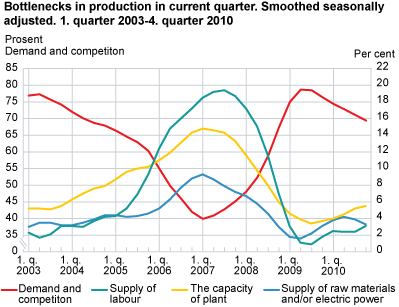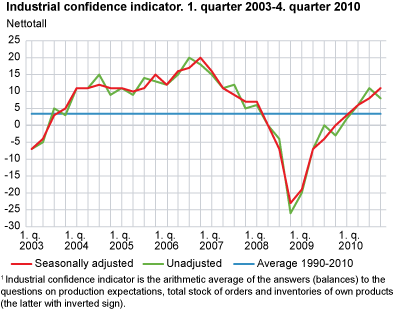Content
Published:
This is an archived release.
Higher output in manufacturing
Norwegian industrial managers report a gradual improvement in the business cycle. However, average capacity utilisation was still quite moderate.
According to the business tendency survey, the Norwegian manufacturing industry experienced moderate growth in total output in the fourth quarter of 2010. A further increase in new orders from home and export markets explains this development. The growth in demand had a positive effect on market prices, which rose after a period of decline. Poor demand and fierce competition still played a major role in restricting production. However, the fall in employment showed signs of levelling out. A similar development was recorded for investments. The number of working months covered by the current stock of orders has risen throughout 2010 and was higher than the historical average for manufacturing. Average capacity utilisation is estimated at 78.6 per cent in the fourth quarter. International comparisons of average capacity utilisation are available from EUROSTAT .
Prospects of improved conditions
Norwegian industrial mangers consider the general short-term outlook (Q1 2011) to be improving. Prospects of further growth in new orders and market prices support this view. The industrial confidence indicator has increased from 8 to 11 (seasonally-adjusted net figure). The result implies a somewhat steeper growth in the business cycle. International comparisons of the industrial confidence indicator are available from EUROSTAT (EU), the Swedish National Institute of Economic Research (Sweden) and Statistics Denmark .
Higher employment among producers of intermediate goods
Sectors producing intermediate goods (wood and wood products, paper and paper products, non-metallic mineral products, basic metals etc.) experienced stronger growth in output, and the employment rose for the first time since 2008. A further increase in new orders from home and export markets explains these results. The rise in demand had a positive effect on market prices, which improved in the fourth quarter. Average capacity utilisation is estimated at 79.2 per cent.
Many respondents consider the general short-term outlook (Q1 2011) to have improved, and the investments seem to be growing. Prospects of a further increase in output, new orders and market prices explain this development.
Prospects of improved conditions for producers of capital goods
Sectors producing capital goods (machinery and equipment, ships, boats and oil platforms etc.) experienced a further decline in output and employment. Poor demand and fierce competition played a major role in restricting the production. The supply of new orders from domestic markets was somewhat higher than in the third quarter, while the supply of new orders from export markets was more or less unchanged. Market prices, however, continued to fall. The number of working months covered by the current stock of orders continued to grow in the fourth quarter, and average capacity utilisation is estimated at 79.5 per cent.
A growing number consider the general short-term outlook (Q1 2011) to have improved, and the decline in investments shows signs of levelling out. Prospects of a rise in output, employment and new orders explain this development.
Higher demand for consumer goods
Sectors producing consumer goods (food products, printing and reproduction, basic pharmaceuticals, furniture etc.) experienced further growth in output. Employment, however, continued to fall. Structural changes within the food and beverages sector contributed to this decline. Domestic demand for consumer goods was significantly stronger in the fourth quarter. Demand from export markets also continued to grow. The rise in demand had a positive effect on market prices. Average capacity utilisation is estimated at 76.5 per cent.
The general short-term outlook (Q1 2011) is considered to be improving. Prospects of a rise in output, demand and market prices support this view.
| Industry | Prospects | Background | |||||||||||||||||||||||||||||||||||||||||||||||||||||||||||||||||||||||||||||
|---|---|---|---|---|---|---|---|---|---|---|---|---|---|---|---|---|---|---|---|---|---|---|---|---|---|---|---|---|---|---|---|---|---|---|---|---|---|---|---|---|---|---|---|---|---|---|---|---|---|---|---|---|---|---|---|---|---|---|---|---|---|---|---|---|---|---|---|---|---|---|---|---|---|---|---|---|---|---|---|
| Food, beverages and tobacco | ++ | Higher levels of production and capacity utilisation in Q4. Growth in demand and increase in market prices. The general outlook for Q1 2011 is considered to be positive. Expectations of positive development in output, demand and market prices. | |||||||||||||||||||||||||||||||||||||||||||||||||||||||||||||||||||||||||||||
| Wood and wood products | ++ | Growth in output, capacity utilisation and employment. New orders and market prices in the domestic market have increased, while new orders and prices from the export market are reduced. The general outlook for Q1 is judged to be improving. Expectations of further growth in output and new orders. Domestic market prices are expected to rise. | |||||||||||||||||||||||||||||||||||||||||||||||||||||||||||||||||||||||||||||
| Paper and paper products | + | More or less unchanged levels of production and capacity utilisation. Reduced level of employment. New orders from the domestic market have declined, while export orders have increased. Increase in market prices. Many managers consider the general outlook to be positive. The levels of output, new orders and market prices are expected to rise in Q1. | |||||||||||||||||||||||||||||||||||||||||||||||||||||||||||||||||||||||||||||
| Basic chemicals | ++ | Higher levels of production and capacity utilisation. Moderate growth in employment. Increase in new orders and market prices. Many managers judge the general outlook for Q1 to be improving, but shortage of capacity is a limiting factor for production. There are expectations of further growth in output, new orders and market prices. | |||||||||||||||||||||||||||||||||||||||||||||||||||||||||||||||||||||||||||||
| Non-ferrous metals | + | Growth in output, but decline in employment. Increase in new orders and higher market prices. The general outlook for Q1 is judged to be improving. Expectations of further growth in the levels of production, new orders and market prices. | |||||||||||||||||||||||||||||||||||||||||||||||||||||||||||||||||||||||||||||
| Fabricated metal products | + | More or less unchanged levels of production and new orders, and decline in the level of employment. Domestic market prices have increased, while export prices have declined. Many managers consider the general outlook for Q1 to be improving. There are expectations of growth in output, new orders and market prices in the forthcoming quarter. | |||||||||||||||||||||||||||||||||||||||||||||||||||||||||||||||||||||||||||||
| Computer and electrical equipment | +(-) | Reduced levels of output and employment. Increase in the stock of orders due to rise in new orders from the export market. Decline in market prices in the domestic and export markets. The general outlook for Q1 is judged to be improving. Expectations of growth in output and new orders. A further decline in market prices is expected. | |||||||||||||||||||||||||||||||||||||||||||||||||||||||||||||||||||||||||||||
| Machinery and equipment | -(+) | Decline in output and employment. Total stock of orders is reduced due to a decline in new orders from the domestic market. Reduced market prices. The general outlook for Q1 is considered to be improving, and there are expectations of higher levels of production and new orders. A further reduction in market prices is expected. | |||||||||||||||||||||||||||||||||||||||||||||||||||||||||||||||||||||||||||||
| Ships, boats and oil platforms | -(+) | Reduction in output and capacity utilisation in Q4. Decline in the total stock of orders due to a reduction in new orders from the export market. Decline in market prices. The general outlook for Q1 is considered to be positive and the drop in employment has stopped. The levels of production, new orders and employment are expected to increase in Q1. | |||||||||||||||||||||||||||||||||||||||||||||||||||||||||||||||||||||||||||||
| Repair, installation of machinery | +(-) | More or less unchanged levels of production, capacity utilisation and employment. New orders from the domestic market have increased, while new orders from the export market are reduced. Decline in market prices. The general outlook for Q1 is judged to be improving. Expectations of positive development in output, employment and new orders. | |||||||||||||||||||||||||||||||||||||||||||||||||||||||||||||||||||||||||||||
| The column for Prospects shows an overall evaluation of the present situation and expected short-term developments using the symbols + and -. The following codes and constellations are used: |
++
+ ² - -- -(+) +/- |
Very good
Good Stable Poor Very poor Good, but with certain negative indications A situation where the + and - factors even out. |
|||||||||||||||||||||||||||||||||||||||||||||||||||||||||||||||||||||||||||||
Industrial confidence indicator (ICI)The indicator is the arithmetic average of the responses (balances) to the questions on production expectations, total stock of orders and inventories of own products (the latter with an inverted sign). The indicator is a guide to the level of industrial production since:
TimelinessThe survey data was collected in the period between 10 December 2010 and 20 January 2011. |
Additional information
The statistics provide current data on the business cycle for manufacturing, mining and quarrying by collecting business leaders’ assessments of the economic situation and the short term outlook.
Contact
-
Edvard Andreassen
E-mail: edvard.andreassen@ssb.no
tel.: (+47) 40 90 23 32
-
Ståle Mæland
E-mail: stale.maeland@ssb.no
tel.: (+47) 95 05 98 88


